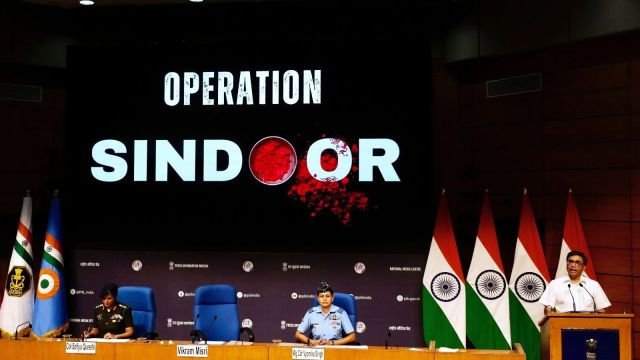Introduction: A Swift and Decisive Response to Terror

On a quiet morning in the Kashmir Valley, the echoes of gunfire shattered the peace. The Pahalgam terrorist attack claimed the lives of 25 Indians and a Nepali national, leaving a nation in mourning and demanding justice. In response, the Indian Armed Forces launched Operation Sindoor—a meticulously planned, surgical strike targeting terrorist infrastructure across Pakistan and Pakistan-occupied Jammu and Kashmir (PoJK).
This was not an act of war against a nation, but a measured, non-escalatory counter-terror operation aimed solely at dismantling the networks behind the bloodshed. Nine key terror hubs were neutralized, sending a clear message: India will no longer tolerate terrorism emanating from across its borders.
In this deep dive, we explore:
✔ What Operation Sindoor entailed
✔ The strategic targets hit and why they mattered
✔ India’s policy of restraint and precision
✔ The global implications of this operation
✔ What comes next in India’s fight against terror
The Trigger: The Pahalgam Massacre
Before understanding Operation Sindoor, we must revisit the gruesome Pahalgam attack—the catalyst for India’s decisive response.

Key Details of the Attack:
- Location: Pahalgam, a serene tourist town in Jammu & Kashmir.
- Casualties: 25 Indians, 1 Nepali national killed.
- Perpetrators: Jaish-e-Mohammed (JeM) and Lashkar-e-Taiba (LeT)—Pakistan-based terror groups with a long history of targeting India.
- Modus Operandi: Heavily armed militants ambushed a civilian convoy.
The attack was not just an act of terror but a deliberate provocation, testing India’s resolve. Prime Minister Narendra Modi had vowed that “the perpetrators will not go unpunished.” Operation Sindoor was the fulfillment of that promise.
What Was Operation Sindoor?
Unlike full-scale military engagements, Operation Sindoor was a high-precision, intelligence-driven strike designed to minimize collateral damage while maximizing impact on terror infrastructure.
Key Features of the Operation:
✅ Discriminate Targeting – Only terror launchpads, not Pakistani military installations.
✅ Non-Escalatory – Avoided actions that could trigger a wider conflict.
✅ Swift & Covert – Conducted with minimal prior publicity to ensure surprise.

The Nine Targets Hit
| Location | Terror Group | Significance |
|---|---|---|
| Markaz Subhan Allah, Bahawalpur | JeM | JeM’s key recruitment & training hub |
| Markaz Taiba, Muridke | LeT | Headquarters of Lashkar-e-Taiba |
| Sarjal, Tehra Kalan | J… | Key transit point for infiltrators |
| Mehmoona Joya, Sialkot | HM (Hizbul Mujahideen) | Arms storage & militant hideout |
| Markaz Ahle Hadith, Barnala | LeT | Radicalization center |
| Markaz Abbas, Kotli | JeM | Operational command post |
| Maskar Raheel Shahid, Kotli | JeM | Training facility for suicide bombers |
| Shawai Nalla Camp, Muzaffarabad | LeT | Launchpad for cross-border attacks |
| Syedna Bilal Camp, Muzaffarabad | JeM | Logistics & communication hub |
Each of these locations had been meticulously surveilled before the strike, ensuring maximum damage to terror networks while avoiding civilian harm.
Why These Targets?
India’s selection of targets was strategic, not random. Here’s why these locations were critical:
1. Disrupting Command & Control
- Muridke (LeT HQ) and Bahawalpur (JeM HQ) were nerve centers for terror operations.
- Destroying them meant delaying future attacks and crippling leadership.
2. Cutting Off Infiltration Routes
- Sarjal (Tehra Kalan) and Shawai Nalla (Muzaffarabad) were key transit points for militants crossing into India.
3. Eliminating Arms & Training Facilities
- Mehmoona Joya (Sialkot) stored weapons, while Maskar Raheel Shahid (Kotli) trained suicide bombers.
4. Countering Radicalization
- Markaz Ahle Hadith (Barnala) was a recruitment hub, radicalizing youth into jihad.
By hitting these nodes, India ensured long-term degradation of terror capabilities.
India’s Restraint: A Message to Pakistan & the World
Unlike Pakistan’s indiscriminate shelling along the LoC, India’s operation was:
✔ Precision-based (only terror camps, no military targets)
✔ Legally justified (self-defense under UN Charter, Article 51)
✔ Diplomatically sound (avoided escalation while asserting strength)
This approach forced Pakistan into a dilemma:
- If they retaliated, they’d be seen as protecting terrorists.
- If they didn’t, they’d admit their terror infrastructure existed.
Global Reactions & Implications
Supportive Nations:
🇺🇸 USA: “India has the right to defend itself.”
🇫🇷 France: “Terrorism cannot be tolerated.”
🇷🇺 Russia: Backed India’s anti-terror stance.
Pakistan’s Response:
- Denied existence of terror camps (despite satellite evidence).
- Threatened “befitting response” but took no concrete action.
What This Means for Future Counter-Terror Ops:
- India has set a precedent: Cross-border strikes will be used if needed.
- Pakistan’s credibility eroded: Global pressure to act on terror groups will increase.
Conclusion: Justice Served, But the Fight Continues
Operation Sindoor was more than a military strike—it was a statement. India has shown that:
✔ Terrorism will be met with decisive force.
✔ Restraint does not mean weakness.
✔ The world stands with victims, not perpetrators.
What’s Next?
- Will Pakistan finally dismantle terror networks?
- Will the UN take stronger action against state-sponsored terror?
Your Thoughts?
Do you believe Operation Sindoor will deter future attacks? Comment below!
